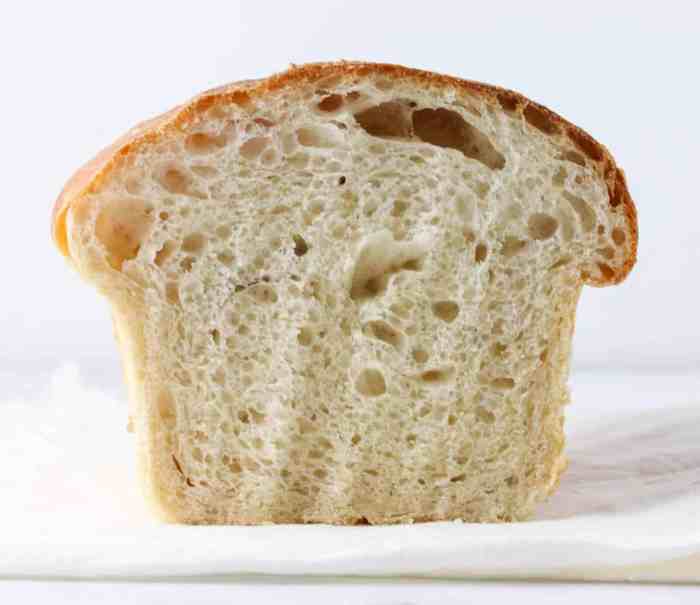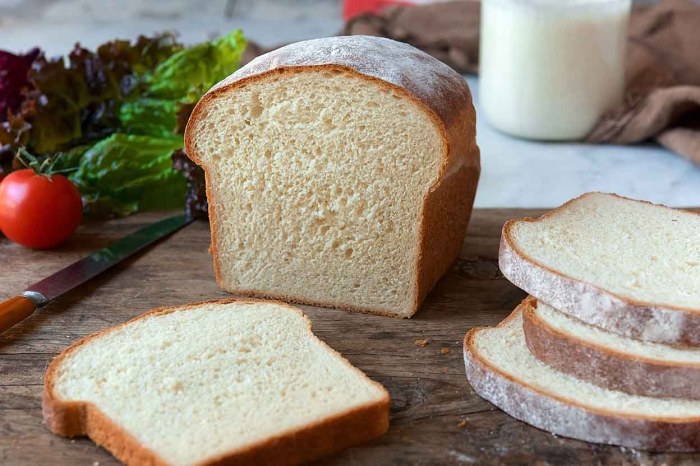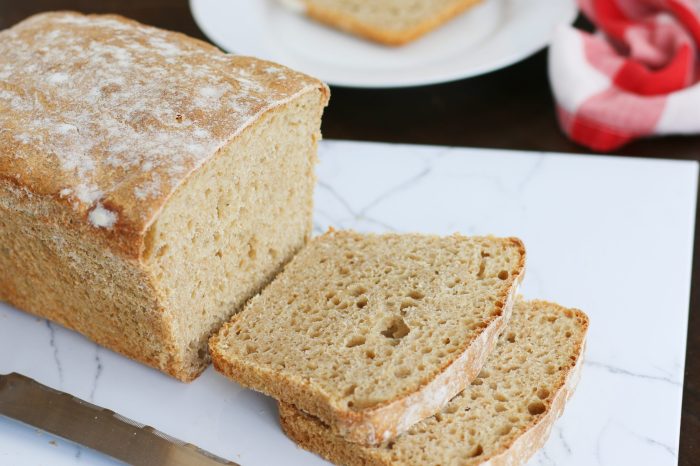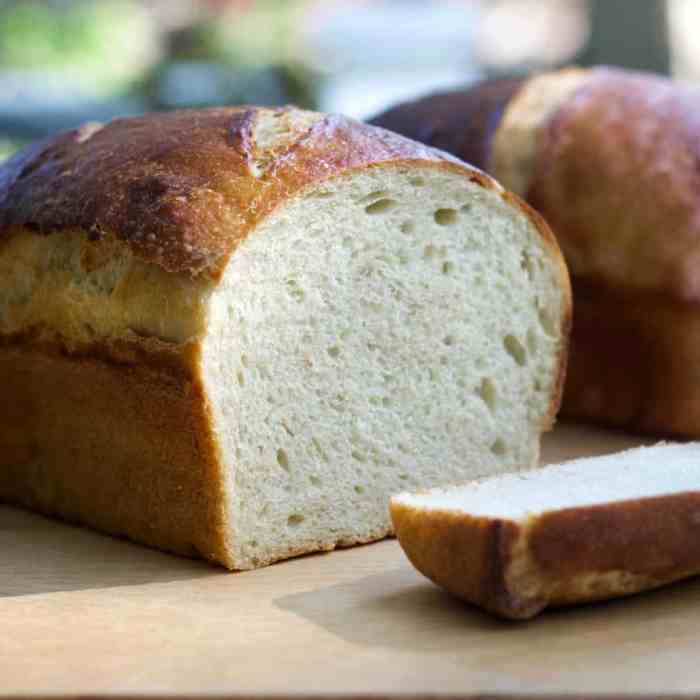Sourdough sandwich bread recipe is more than just a recipe; it’s a journey into the world of homemade bread, where patience meets flavor and tradition meets innovation. This recipe invites you to create a bread that’s not only delicious but also packed with the unique tang and texture that only sourdough can offer.
It’s a recipe that encourages experimentation, where you can personalize your loaf with herbs, seeds, or even different flours, resulting in a truly unique and satisfying sandwich experience.
The magic of sourdough lies in its starter, a living culture of wild yeast and bacteria that gives the bread its distinctive sour taste and airy texture. The process of nurturing a starter is a rewarding one, as you witness the transformation of simple flour and water into a bubbly, active culture.
This starter becomes the foundation of your bread, imparting its unique character to every loaf you bake.
Introduction to Sourdough Sandwich Bread
Sourdough bread, with its tangy flavor and chewy texture, has been a staple food for centuries. Its origins can be traced back to ancient Egypt, where bakers discovered that using a mixture of flour and water, left to ferment naturally, resulted in a unique and flavorful bread.
The use of a sourdough starter, a living culture of wild yeast and bacteria, is what sets this bread apart from other varieties.Sourdough bread has gained immense popularity in recent years, thanks to its health benefits and distinctive flavor. Its unique characteristics make it an excellent choice for sandwiches, offering a satisfying crunch and a subtle tang that complements a wide range of fillings.
The Role of the Sourdough Starter
The sourdough starter is the heart and soul of sourdough bread. It’s a living culture of wild yeast and lactic acid bacteria that feed on flour and water, producing a mixture that acts as a natural leavening agent. The starter is responsible for the bread’s unique flavor, texture, and overall quality.The wild yeast in the starter ferments the sugars in the flour, producing carbon dioxide gas, which causes the dough to rise.
The lactic acid bacteria, on the other hand, break down the starches in the flour, contributing to the bread’s tangy flavor and improving its digestibility. The starter’s activity also influences the bread’s texture, resulting in a more open crumb structure and a chewy, elastic texture.
This makes sourdough bread ideal for sandwiches, as it can hold fillings without becoming soggy.
Ingredients and Equipment
This recipe requires a few essential ingredients and some basic kitchen equipment. The ingredients work together to create a delicious, flavorful, and satisfying sourdough sandwich bread. The equipment is necessary for proper mixing, rising, and baking.
Ingredients
The following ingredients are necessary for making sourdough sandwich bread:
- Sourdough Starter:The heart of sourdough bread, the starter provides the unique tangy flavor and airy texture. It’s a living culture of wild yeast and bacteria, which ferments the flour and water, producing lactic acid and carbon dioxide.
- Flour:The primary ingredient, flour provides the structure and body of the bread. High-protein bread flour, with a higher gluten content, is preferred for sandwich bread, as it results in a more robust and chewy texture.
- Water:Water is essential for activating the yeast in the starter and for hydrating the flour. The amount of water used influences the dough’s texture and the bread’s crumb.
- Salt:Salt enhances the flavor of the bread and strengthens the gluten structure, contributing to a more even rise and a chewier texture.
Equipment
The following equipment is necessary for making sourdough sandwich bread:
- Mixing Bowls:You’ll need at least two bowls: one for mixing the starter and flour and another for kneading the dough.
- Measuring Cups and Spoons:Accurate measuring is essential for consistent results.
- Kitchen Scale:A kitchen scale is highly recommended for precise measurements, especially for flour and water.
- Mixing Spoon or Spatula:For mixing the ingredients.
- Dough Scraper:A dough scraper is useful for moving and shaping the dough.
- Dutch Oven:A Dutch oven is ideal for baking sourdough bread, as it creates a moist environment that promotes even rising and a beautiful crust.
- Baking Sheet:A baking sheet is necessary if you’re not using a Dutch oven.
- Parchment Paper:Parchment paper helps prevent the dough from sticking to the baking sheet.
Sourdough Starter Preparation
The heart of any sourdough bread lies in its starter, a lively mixture of flour and water that harbors wild yeast and bacteria. This living culture is responsible for the unique tangy flavor and airy texture of sourdough.
Creating a Sourdough Starter
To create a sourdough starter, you’ll need a few simple ingredients and a little patience. Here’s a detailed recipe:* Ingredients:
1 cup (120g) all-purpose flour
1 cup (240ml) water (filtered or bottled is recommended)
Instructions
Day 1
Combine the flour and water in a clean jar, mixing well until there are no lumps. Cover the jar loosely with a breathable cloth or paper towel and secure with a rubber band. Let the mixture sit at room temperature (ideally 70-75°F) for 24 hours.
Day 2
Stir the mixture thoroughly. You may see some bubbles forming on the surface, indicating the presence of yeast. Cover and let sit for another 24 hours.
Day 3-7
Continue to stir the starter daily. You’ll notice the mixture becoming more active with bubbles and a slightly sour smell. The starter will rise and fall, a sign of fermentation.
Feeding
Once the starter is active and showing signs of fermentation, it’s time to start feeding it. To feed the starter, discard half of the starter and replace it with equal parts fresh flour and water. For example, if you have 100g of starter, discard 50g and add 25g flour and 25g water.
Maintaining
Continue feeding the starter every 12-24 hours, depending on its activity. You can adjust the feeding schedule based on your starter’s behavior.
Maturity
Your starter is mature and ready to use when it doubles in size within 4-6 hours after feeding.
Feeding and Maintaining a Sourdough Starter
Once you have a thriving sourdough starter, you need to maintain it to keep it healthy and active. Here are some tips for feeding and maintaining your starter:* Regular Feeding:Feeding your starter regularly is crucial for its survival. The frequency of feeding depends on the activity of your starter and the temperature of your environment.
A general rule of thumb is to feed it every 12-24 hours.
Feeding Ratio
The traditional feeding ratio for sourdough starter is 1:1:1, meaning equal parts starter, flour, and water. However, you can experiment with different ratios to find what works best for your starter.
Storage
When not in use, store your starter in the refrigerator. It will slow down its activity but remain alive. Feed it once a week or every few days to keep it active.
Temperature
The ideal temperature for sourdough starter is around 70-75°F. If the temperature is too cold, the starter will slow down; if it’s too hot, it may become too active and potentially die.
Troubleshooting Common Sourdough Starter Issues
Even with the best care, sourdough starters can sometimes encounter issues. Here are some common problems and solutions:* Starter Not Rising:This could be due to several factors, including low activity, insufficient feeding, or a cold environment. Try increasing the feeding frequency, raising the temperature, or using a different type of flour.
Starter Too Sour
If your starter becomes too sour, it may be overfed or exposed to too high a temperature. Try reducing the feeding frequency or lowering the temperature.
Starter Smells Bad
A bad smell could indicate mold or bacteria contamination. Discard the starter and start a new one if you suspect contamination.
Starter Not Active
If your starter is inactive, it may need to be revived. Try feeding it more frequently or raising the temperature. If it still doesn’t show signs of activity, it may be dead and you’ll need to start a new one.
Dough Preparation

The magic of sourdough sandwich bread starts with the dough. This is where you bring together the sourdough starter, flour, water, and salt to create a beautiful, elastic dough that will rise magnificently and bake into a loaf that is both delicious and satisfying.
Mixing the Dough, Sourdough sandwich bread recipe
The process of mixing the dough is a simple but essential step. It involves combining the ingredients in a bowl and using a technique called “folding” to develop the gluten in the dough.
- Combine the sourdough starter, flour, and water in a large bowl. You can use a stand mixer with a dough hook or a large bowl and a spatula for this step. The goal is to create a shaggy, sticky dough.
- Let the dough rest for 30 minutes. This allows the gluten to relax and makes it easier to knead.
- After resting, sprinkle the salt on top of the dough and fold the dough over itself several times. You are essentially stretching and folding the dough, which helps to develop the gluten.
- Repeat the folding process every 30 minutes for a total of 3-4 times. You can use a bench scraper to help with the folding process. As you fold, you’ll notice the dough becoming smoother and more elastic.
Kneading the Dough
Kneading is the most important part of the dough preparation process. It’s the process of working the dough to develop the gluten, which gives the bread its structure and chewiness.
- Once the dough has been folded for the last time, transfer it to a lightly floured surface. Knead the dough for 10-15 minutes, or until it is smooth and elastic. This means the dough will bounce back when you poke it with your finger.
- You’ll know the dough is properly kneaded when it passes the “windowpane test.” This test involves stretching a small piece of dough until it’s thin enough to see light through it. If the dough doesn’t tear easily, it’s properly kneaded.
Dough Hydration
Dough hydration is the ratio of water to flour in the dough. It’s a crucial factor in determining the texture of your bread.
- High Hydration Doughs (75%- 85%): These doughs are very wet and create a bread with an open crumb and a chewy texture. They are often used for rustic loaves or sourdough breads with a tangy flavor.
- Medium Hydration Doughs (65%- 75%): These doughs are more manageable and create a bread with a slightly denser crumb and a softer texture. They are suitable for sandwich loaves, rolls, and baguettes.
- Low Hydration Doughs (55%- 65%): These doughs are dry and create a bread with a tight crumb and a firmer texture. They are often used for pizza dough or flatbreads.
For sourdough sandwich bread, aim for a medium hydration dough (around 70%). This will result in a loaf with a good balance of chewiness and tenderness, making it perfect for sandwiches.
Gluten Development
Gluten is a protein complex formed when flour is mixed with water. It gives the dough its structure and elasticity. Proper gluten development is essential for a good sourdough sandwich bread.
- Underdeveloped Gluten:This results in a dense, crumbly bread that lacks structure and chewiness.
- Overdeveloped Gluten:This results in a tough, rubbery bread that is difficult to chew.
- Properly Developed Gluten:This results in a bread with a good balance of chewiness and tenderness, perfect for sandwich bread.
You can achieve proper gluten development by following the kneading instructions above.
First Rise (Bulk Fermentation)
This is the first major rise of your sourdough bread, where the dough will significantly increase in size. Bulk fermentation is a crucial step in developing the unique flavor and texture of sourdough bread. During this time, the yeast in your starter will continue to consume sugars in the flour, producing carbon dioxide gas and organic acids.
Optimizing Fermentation Time and Temperature
The duration of the bulk fermentation depends on several factors, including the temperature of your kitchen, the activity of your starter, and the hydration of your dough. The ideal temperature for bulk fermentation is between 70-75°F (21-24°C). At this temperature, the yeast will work optimally, producing a well-fermented dough.
Notice tips parlay mix akurat for recommendations and other broad suggestions.
- Temperature Control:If your kitchen temperature is too cold, consider placing the dough in a warm location, like an oven with the light turned on. If it is too warm, move the dough to a cooler spot or even place it in the refrigerator for a slower rise.
- Proofing Basket:Once the dough has risen to about double its original size, you can gently shape it into a ball and place it in a lightly floured proofing basket or bowl. The basket will help the dough maintain its shape and develop a nice crust.
Signs of a Properly Fermented Sourdough Dough
The key to a successful sourdough bread is recognizing the signs of a properly fermented dough. The dough should be airy and elastic, with a slightly bubbly texture.
- Rise:The dough should have risen to about double its original size. It should also feel light and airy to the touch.
- Smell:A properly fermented sourdough dough will have a pleasant, slightly tangy aroma. This is a sign that the yeast has worked its magic, converting sugars into flavorful compounds.
- Texture:The dough should be smooth and elastic. It should spring back when you poke it with a finger.
Shaping and Proofing
The shaping process transforms the dough into a well-defined loaf, while proofing allows the yeast to continue fermenting, resulting in a light and airy bread.
Shaping the Dough
The shaping technique for a sandwich loaf aims to create a rectangular shape with a consistent volume. This shape ensures even baking and facilitates slicing into uniform pieces.
- Folding the Dough:Start by gently folding the dough into itself several times. This helps to develop the gluten structure and create a more cohesive dough.
- Forming the Loaf:After folding, gently shape the dough into a rectangle. Ensure the edges are even and smooth.
- Transfer to a Loaf Pan:Place the shaped dough in a greased loaf pan. Gently press the dough into the corners of the pan, ensuring it fills the entire space.
Proofing the Dough
Proofing is a crucial step that allows the yeast to ferment the dough further, increasing its volume and creating a light and airy texture.
- Proofing Environment:Proof the dough in a warm, humid environment. This can be achieved by placing the loaf pan in a large bowl with a damp towel draped over it.
- Proofing Time:The proofing time will vary depending on the temperature and humidity. A well-proofed dough will rise to about 1.5 times its original size.
- Signs of a Well-Proofed Dough:A well-proofed dough will have a soft and springy texture. When gently pressed, the dough will slowly bounce back.
Baking

The baking process for sourdough sandwich bread is crucial for achieving a delicious and well-structured loaf. The right oven temperature and baking time are key to developing a crispy crust and a soft, airy crumb.
Oven Temperature and Baking Time
The recommended oven temperature for baking sourdough sandwich bread is 450°F (232°C) for the first 20 minutes, followed by a reduction to 400°F (204°C) for the remaining baking time. The total baking time will vary depending on the size and shape of your loaf, but it typically ranges from 30 to 45 minutes.
Signs of a Fully Baked Loaf
There are several signs that indicate your sourdough sandwich bread is fully baked:
- The loaf will have a deep golden brown crust.
- When tapped on the bottom, the loaf will sound hollow.
- An instant-read thermometer inserted into the center of the loaf will register 200°F (93°C).
Tips for Achieving a Crispy Crust and a Soft, Airy Crumb
- Use a Dutch oven or a baking stone: These surfaces retain heat well, which helps to create a crispy crust. Preheat the Dutch oven or baking stone for at least 30 minutes before baking.
- Score the loaf before baking: Scoring the loaf allows steam to escape during baking, preventing the loaf from collapsing and creating a more even rise.
- Bake with steam: Adding steam to the oven during the first 10-15 minutes of baking helps to create a soft and airy crumb. You can achieve this by placing a baking sheet filled with water on the bottom rack of the oven or by spritzing the loaf with water several times during baking.
- Cool the loaf completely on a wire rack: This allows the crust to harden and prevents the loaf from becoming soggy.
Cooling and Storing

Allowing your sourdough sandwich bread to cool completely before slicing and storing is crucial for preserving its texture and preventing condensation. Proper storage methods are essential for maintaining freshness and preventing mold growth.
Cooling Methods
Cooling your sourdough bread properly ensures a crisp crust and a soft, airy crumb.
- Wire Rack:Placing the bread on a wire rack allows for air circulation, promoting even cooling and preventing moisture buildup.
- Cooling Rack:A cooling rack is specifically designed for this purpose and provides ample space for air to circulate around the bread.
Storage Recommendations
Storing sourdough sandwich bread correctly helps to retain its freshness and prevent spoilage.
- Room Temperature:For short-term storage (up to 2 days), store the bread at room temperature in a bread bag or airtight container.
- Freezing:To extend the shelf life, freeze the bread for up to 3 months. Wrap it tightly in plastic wrap or aluminum foil to prevent freezer burn.
Preventing Mold Growth
Mold can quickly develop on sourdough bread, especially in humid environments.
- Avoid Moisture:Ensure the bread is completely dry before storing to prevent condensation.
- Airtight Container:Store the bread in an airtight container to prevent exposure to air and moisture.
- Refrigerator:While not ideal for long-term storage, refrigerating the bread can slow down mold growth. However, refrigeration can dry out the bread and affect its texture.
Variations and Applications: Sourdough Sandwich Bread Recipe
The basic sourdough sandwich bread recipe can be easily adapted to create a variety of flavors and textures. Adding ingredients like herbs, seeds, or even nuts can enhance the flavor and nutritional value of your bread. Additionally, the versatility of sourdough sandwich bread makes it ideal for various types of sandwiches, from classic grilled cheese to gourmet creations.
Variations in Sourdough Sandwich Bread Recipes
Adding ingredients to your sourdough sandwich bread recipe can enhance its flavor and texture. Here are some popular variations:
- Herbs:Fresh or dried herbs like rosemary, thyme, or oregano can add a savory depth to your bread.
- Seeds:Adding seeds like sunflower, poppy, or sesame seeds provides a crunchy texture and additional nutrients.
- Nuts:Chopped walnuts, pecans, or almonds can add a nutty flavor and a satisfying crunch to your bread.
Uses of Sourdough Sandwich Bread
Sourdough sandwich bread is a versatile choice for various sandwich types. Here are some examples:
- Classic Grilled Cheese:The slightly tangy flavor of sourdough bread complements the melted cheese and buttery goodness of a classic grilled cheese sandwich.
- Gourmet Sandwiches:The robust flavor of sourdough bread pairs well with gourmet ingredients like roasted vegetables, smoked meats, and artisan cheeses.
- Breakfast Sandwiches:Sourdough bread is a hearty base for breakfast sandwiches, holding up well to eggs, cheese, and bacon or sausage.
Benefits of Using Sourdough Bread for Sandwiches
Sourdough bread offers several benefits over other bread types for making sandwiches:
- Flavor:Sourdough bread has a complex, slightly tangy flavor that adds depth to any sandwich.
- Texture:The dense, chewy texture of sourdough bread provides a satisfying bite and holds up well to fillings.
- Digestibility:Sourdough bread is often easier to digest than other bread types due to the fermentation process, which breaks down complex carbohydrates.
Closing Summary

With a little patience and practice, you can master the art of sourdough sandwich bread baking, creating loaves that are both delicious and satisfying. Whether you’re a seasoned baker or just starting out, this recipe offers a rewarding experience, allowing you to enjoy the fresh, homemade taste of sourdough bread with every sandwich.
The process, from nurturing the starter to shaping the loaf, is an enjoyable one, and the final product, a beautifully golden-brown sourdough sandwich bread, is a testament to your efforts. So, gather your ingredients, fire up your oven, and embark on a journey to create sourdough sandwich bread that’s truly your own.
